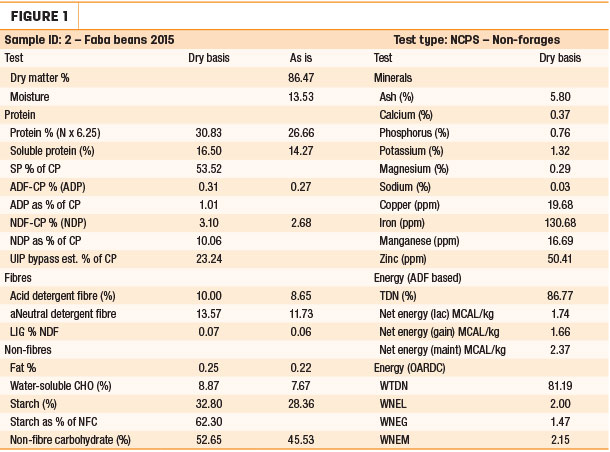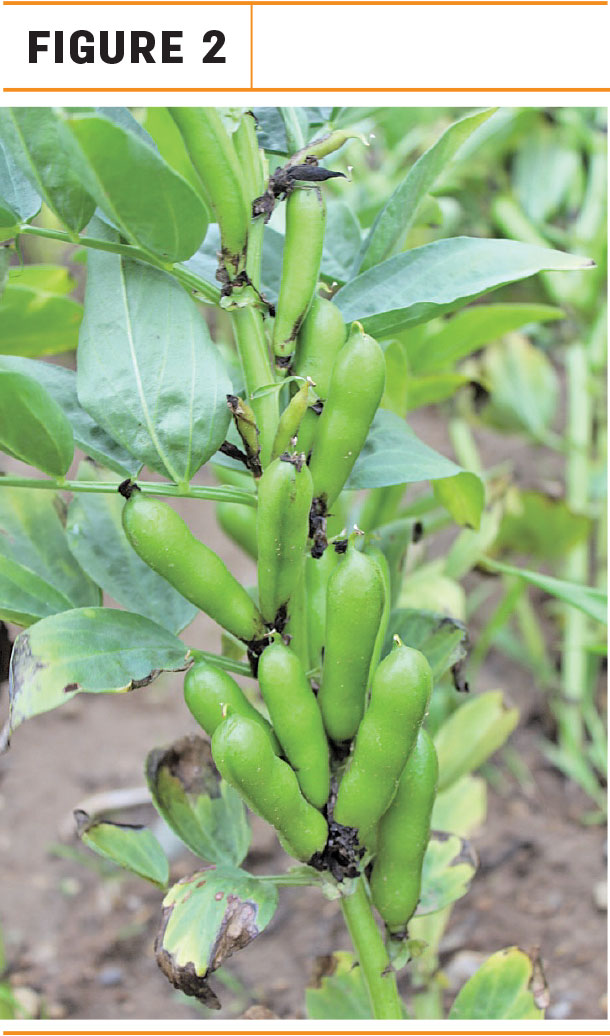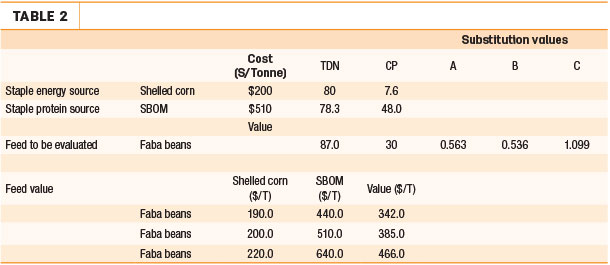Botanically named Vicia faba, its common name is “faba bean,” although it is known to have various other common names such as “horse bean,” “field bean” and “broad bean,” which is an Italian translation of the word “fava” and probably the closest-sounding to the name faba bean.
Nutrition
The common reason for livestock producers to plant faba beans is to obtain a protein source that is homegrown and can easily be processed on-farm, as they contain little oil.
They also do not contain anti-nutritional enzymes and therefore do not need roasting. Faba beans, related to lima beans, contain approximately 30 percent protein and provide a good source of energy from starch.
Figure 1 shows a sample of a 2015 faba beans nutritional analysis report, which had average results for that harvest season with crude protein ranging from 28 percent to 33 percent and soluble protein values between 11.5 percent and 17 percent.

Canadian research showed that no significant difference was seen in milk production when the rations contained either soybean meal or faba beans as the protein source. The energy provided by faba beans, by comparison, is greater than soybean meal but lower than barley.
They are similar to peas in that they are a good source of lysine at a comparable 2-to-1 ratio of lysine to methionine. Faba beans are also rich in thiamin and phosphorus.
Early varieties were known to have an undesirable level of tannin, found mainly in the hull, which reduces protein digestibility. Although it gives the bean more flavour and ruminants can handle the tannins, monogastrics cannot. Over time, varieties have changed to reduce tannins significantly.
Most varieties available within Canada are produced by Germany and the Netherlands. At the flowering stage, it is possible to see whether the variety contains tannins, if the plant has a purple or pink flower.
These are generally used for the food industry. Those without, or extremely low amounts of tannins, will have a white flower and include varieties such as Imposa, Snowbird and Tabasco.
Planting
Faba beans should be inoculated to aid in a more even distribution and quicker nodule formation for maximum nitrogen fixation. Like other pulses, they are an attractive crop for their remarkable nitrogen-fixing ability, limiting the need for additional nitrogen for the subsequent crop.
Faba bean plants use a relatively high amount of phosphorus to promote the development of the root system and seedling growth.
Depending on the available phosphorus in the soil, phosphate can be banded with the seed if required. Studies have shown that phosphorus aids in nitrogen fixation, helps speed up maturity and improves drought tolerance.
Faba beans can be planted with corn or soybean planters, air flow drill, seed drill or, if needed, an alternative seeding mechanism for larger beans, as they can cause some flow problems in distribution systems with smaller hose sizes.
Row widths have varied, depending on preference, from 7.5-inch widths to 30-inch widths, with the most common being 15 inches. The suggested plant population is 180,000 seeds per acre at a depth of 1.5 to 2.5 inches.
It is recommended planting is done by the end of the first week of May, with some setting May 7 as the cut-off date. Faba beans are frost-tolerant and can be put into the ground when the soil temperature is around 3ºC.
Delayed planting has been shown to reduce yield due to late maturation and drought stress when high temperatures are experienced at the time of flowering. A difference in planting time of two weeks can decrease yields by as much as 32 percent.
Growing season
Faba beans have a reasonably long growing season. Being relatively frost-tolerant at the seed stage, they can be planted early without fear of frost kill. However, they do not survive fall frosts. They thrive under cool growing conditions, adapting well to moisture variations, but do not do well in hot, dry climates.
Seeds should be sown in a weed-free field. They are poor competitors to weeds, especially at the seedling stage, since emergence and early development is slower than many other crops.
Upon crop emergence, the field should be inspected for frequency and distribution of weeds, as pre-emergent glyphosates are very effective. Herbicides can also be used but are thought to be less effective than pre-emergence treatments.
In general, the plants grow to a height of 3 to 5 feet, depending on growing season and variety. Once the flowering starts, it continues to grow and flower up the plant, while the bottom flowers become pods (Figure 2).

A flower cluster can produce up to six pods, each up to 10 centimeters long and up to 1.5 centimeters wide with four to six beans per pod, turning from green to brown to black in colour as it matures.
Production and yield
Western Canada started the commercial production of faba beans in 1972 as a substitute for soybean meal, primarily in livestock rations. In recent years, it has also replaced canola in diets. In 2013, it was estimated that Alberta grew close to 16,000 acres of faba beans.
In Ontario, however, the acreage has been much less, but it is increasing. Southern Ontario planted around 400 acres of faba beans in 2015. This year that number increased to around 1,000 acres in southern Ontario, where northern Ontario reached more than 2,000 acres.

Due to their yield, less acreage is needed to grow the same bushel weight on an acre when compared to soybeans. In 2014, the average soybean yield for southern Ontario was 45.5 bushels per acre where faba beans yielded approximately 85 bushels per acre. That same year, canola averaged 43.1 bushels per acre.
In terms of the value of faba beans per tonne (36.7 bushels per tonne), Table 2 shows how the Petersen’s Equation can be used to calculate the value of alternative feeds, in this case faba beans.

Values based on their protein and energy contents are used in comparison to the nutritive value and cost of corn and soybean meal. In addition, corn and soybean meal total digestible nutrients and crude protein values are used to obtain substitution values A, B and C.
The substitution values are an indication of the rate at which the test feed must be fed to supply the same nutrients as the staple sources it replaces. One tonne of feed to be evaluated replaces A tonnes of energy source plus B tonnes of protein source in the ration.
If C is greater than 1, nutrient density increases and feed required per animal will be lower. If C is less than 1, the use of the feed being evaluated decreases nutrient density and will require greater feed intake.
The table shows the feed value of faba beans using three different costs, per tonne, for the soybean meal and corn, as we know these values change constantly. In the table, the value of faba beans ranges between $342 and $466, as the value of corn and soybean meal ranges between$190 to $220 and $440 to $640 per tonne, respectively.
The website (OMAFRA: Feed Values) contains a further explanation and an active link that can be used to do Petersen Equations for calculating feed values.
Disease pressure and control
There are a few diseases that could potentially affect the faba bean during its growing season. Depending on the growing conditions, gray mold (Botrytis), white mold (Sclerotinia), seedling blight and foot rot can negatively affect the faba bean.
Foot rot and seedling blight are caused by warm temperatures, whereas both mold strains are caused by cool temperatures. Wet soil conditions favour all three diseases. In narrower row spacing, mold may be more prominent than in wider spacing, due to trapped moisture in wet conditions.
Treatment and prevention methods are disease-specific. For example, while fungicide is effective on white and gray molds, it has no effect on foot rot because it will be too late once the symptoms appear, and the product used is not carried down to the roots.
In the case of foot rot, using treated high-quality seeds would be the best prevention method. Like many other crops, the faba bean is affected by pests: aphids, leafhoppers, pea leaf weevils, grasshoppers and the most common, the lygus bug. S
couting at the pod development stage will help monitor lygus bug populations which, if needed, can be controlled with a range of insecticides.
Harvest
Faba beans take about 110 to 130 days to mature, depending on the variety. As the faba beans mature, the lower leaves darken and drop, and the pods turn black and dry progressively up the stem. At the time of maturation, focus should be given to the bottom pods.
Generally, around the last week of August, the plant will be mature and 80 to 85 percent of the bottom pods will have darkened, at which time they are ready to be dried down with a spray, also called desiccation.
Desiccation is considered a must since not all of the pods will dry at the same time like the head of wheat does. Approximately eight to 10 days after desiccation, the beans are ready for harvest. There is some variation between provinces as to when to desiccate, but all fall within 80 to 90 percent blackened pods.
As the plants are left standing and fully mature, the chances of shattering increases, and as drying continues to 12 to 14 percent moisture, caution is needed as they are dry enough for the pods to fall off with a simple touch.
Preferably, they can be combined between 16 percent to 18 percent moisture and aerated to 14 percent moisture for storage. If moisture at harvest is higher, a two-stage drying method is recommended, separated by a day to allow for moisture to move towards the surface of the seed.
If heat is required for drying, it should not exceed 32ºC to prevent hardening of the seed coat. Drop distances must be minimized to reduce cracking. As a quick rule of thumb for testing their moisture content, faba beans can be bitten through and, if the texture is cheesy, they are more than 15 percent.
If they are hard and remain intact when biting them, they are less than 15 percent. On-farm processing for faba beans can be done with a roller mill or a 3/8” screen on a hammer mill or hay buster.
Swathing is another method by which faba beans can be harvested. The optimum time to swath a faba bean plant is when 25 percent of the plants in the field are starting to show black up to the third pod from the bottom.
They are then left to dry and combined when the moisture content of the bean is at 18 to 20 percent, preferably in the morning, as drydown may continue during the day, to prevent shatter losses if moisture content decreases. Harvested beans can then be dried down further to 14 percent for storage.
In addition to harvesting the beans to dry down, other options like high-moisture faba bean and harvesting the whole plant for use as forage are options being pursued.
Faba bean silage is palatable and can be harvested as a direct cut or wilted down to 30 to 35 percent dry matter with an end result of approximately 17 to 18 percent crude protein.
Faba beans are similar to many other pulses, such as dried peas and beans; they can be fed in various ways. Likewise, it can be fed to monogastrics and ruminants. Consequently, the faba bean has certainly proven to be an excellent feed source around the world for decades and continues to do so. ![]()
The author would like to acknowledge Dairy Vision Consulting, distributor of the faba bean seed, for its contribution of information to this article.

-
Anita Heeg
- Feed Ingredients and Byproducts Specialist
- OMAFRA
- Email Anita Heeg









